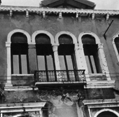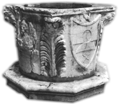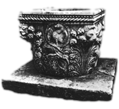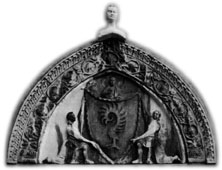|

The Venetian-Byzantine
Quadruple round-arched windows

The well
with the Cappello coat-of-arms

The garden's well
with the Malipiero coat-of-arms

The garden entrance
|

The Venetian - Byzantine door
on which are sculpted the Malipiero coat-of-arms
The
Cà Grande of Saint Samuel
As with most Venetian
palaces, the Cà Grande (big palace) of San Samuele is built
as two main superposed floors, but unlike the other palaces, each
floor
is accessed by its own
independent entrance hall, stairway and porta d'acqua
(water door).
Through the ancient byzantine door one accesses "the secondo piano nobile" (second main floor). The main
door opens onto a large seventeenth century entrance
hall leading to the magnificent "primo piano nobile" (first main floor)
and to the ancient medieval court-yard, the nineteenth century garden
and the door on the Grand
Canal.
The architectural development of the Cà Grande of San
SamueleSamuele is similar to the traditional evolution of many
Venetian palaces, the freedom and the harmony of structures
underpinning the vivid rhythms and original fascination of the city.
In fact the structure of the building is made of three parts, each
closely merged the others, representing three eras: the
Byzantine, the Gothic and Seventeenth century's one.
The original part of the building
was probably built between the 10th and the 11th century by Soranzo family
in Veneto-Byzantine style, as evidenced by the large door (number 3201)
and the four-lights window with round arches (later
amalgamated into the gothic structure) visible on the San Samuele side.
In the middle of the 14th century, the Soranzo
added a second floor to the Cà Grande, as the pointed
arch windows. This Gothic design was perfectly mixed with the floor
below, respecting and incorporating elements of the Byzantine
construction.
By mid of 15th century the Cappellos decided to expand the ancient
Palace, too narrow at that time. Building on an anused area, on the garden'
side, the facade on the Grand Canal was widened to the dimension we enjoy today.
Restorating and enlarging the building was also the main concern of
Caterino Malipiero, as the date 1622 and the initials K.M.
(Caterino Malipiero) engraved on the main
door accessing the new large Palace entrance.
The family’s coat-of-arms with cock's claws is also proudly sculpted
there. In the second half of the seventeenth century, Palazzo Malipiero,
with its
architectural aspect that ignores Baroque, was one of the richest and
most meaningful buildings in Venice.
In the first half of 18th century the Malipiero
family, in accordance with an architectural project now lost, decided
to enlarge their Palace connecting it with some houses abutting it
on its rear, eliminating the street (named Calle Malipiero)that separeted them.
The facade on Campo San Samuele was extended backwards by 30 meters;
the garden was widened to include part of the already existing Ramo
Malipiero which bodered the Palace on the garden side, and a new perspective
was created from the Palace's main entrance to the garden.
This can be easily seen on the drawing of 1718 by Luca
Carlevarjs reproduced in the site home
page. On it the palace ended just after the two main entrances
and a Calle borders its back and separates it from the other houses
that now are part of the building. The drawing clearly depict further back the
Calle della Commedia where Giacomo Casanova was born, and which was
later renamed Calle Malipiero.
During the 19th century the venerable Cà Grande of the Soranzos,
Cappellos and Malipieros was neglected but kept intact in its
Seventeenth-century structure; and was only at the beginning of the
20th century that the palace saw some restoration. Then, in the early 1950'
the Barnabò family started a complete renovation project.
The works, directed by Nino Barbantini restored the ancient charm to
the palace, its interiors and to the garden.
Therefore, only thanks to the new owners' arrival at the beginning of the 21st century, Palace Malipiero will be able to aspire at receiving attention worthy by people capable both of respecting and taking care of it.
|